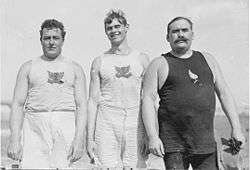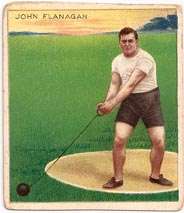John Flanagan (athlete)
 Flanagan posing with 16 lb. hammer weight in 1908 | ||
| Medal record | ||
|---|---|---|
| Men's athletics | ||
| Representing the | ||
| Olympic Games | ||
| | 1900 Paris | Hammer throw |
| | 1904 St. Louis | Hammer throw |
| | 1908 London | Hammer throw |
| | 1904 St. Louis | Weight throw |


John Flanagan (John Joseph Flanagan; January 28, 1868 – June 3, 1938) was a three-time Olympic gold medalist in the hammer throw, winning in 1900, 1904, and 1908.
John Flanagan was born in the townland of Kilbreedy East, near Martinstown in County Limerick, Ireland on January 9, 1873. He emigrated to the United States of America in 1896. At that time he already held the world record for the hammer throw. He competed for both the New York Athletic Club and the Irish American Athletic Club, and was part of a group of Irish-American athletes known as the Irish Whales.
In 1900 Flanagan represented his new country at the Olympic Games. Flanagan, the only non-college man to medal for the Americans, outdistanced American athlete Truxtun Hare by 4.75 meters in the hammer throw. Hare and Josiah McCracken, both college football players from Pennsylvania, took silver and bronze. Flanagan also competed in the discus throw, finishing seventh.
Flanagan joined the New York City Police Department (NYPD) in 1903, and his first assignment was to the Bureau of Licenses, where he had a lot of time on his hands, which was mostly used to train at the Irish American Athletic Club in Queens. It was during that time that he became one of the masters of the three-turn technique. In the 1904 Olympic Games, sporting the Winged Fist of the Irish American Athletic Club, Flanagan set a new world record of 168 feet, 1 inch. He placed second to the Canadian, Étienne Desmarteau, in the 56-pound throw event.
In 1905, while attached to the 37th Precinct, Flanagan competed in the Police Athletic Association games held at Celtic Park in New York. "Not only did he win four of weight-throwing events, but, as if to show that he could do a little sprinting as readily as he can outclass his competitors with the 16 and 56 pound weights, he not only had the temerity to enter the fat men's race, but actually won it," giving him a total of five first place victories, "a most commendable showing, for there were many mighty policemen arrayed against him."[1]
In the 1908 Olympics in London, Flanagan broke his own record with a hammer throw of 170 feet, 4.5 inches.[2] The silver that year went to another New York City police officer, the former record holder Matt McGrath. John Flanagan competed in the tug-of-war as well. On July 24, 1909, at the age of 41, Flanagan set his last world record in the hammer, with a throw of 56.18 meters.
Flanagan quit the police force in 1910, after his public office squad was abolished and he was transferred to the West 68th Street Station and forced to walk a beat along Central Park West, giving him no time to train and compete. He returned home to Limerick in 1911 and took over the family farm following the death of his father in 1912. He continued to compete in Ireland and won his final international event when competing against Scotland in 1911. He also won the Irish Hammer Championships of 1911 and 1912. Following his retirement, he coached a number of athletes, including Patrick O'Callaghan, who went on to win two Olympic gold medals in the hammer throw at the 1928 and 1932 games. He died at home in Limerick, aged 70, on 03 June 1938.[3] A statue of Flanagan was erected beside Martinstown Church in Limerick in 2001.
References
- ↑ "Athletic Policemen in Celtic Park Games; World's Champion Weight Thrower, J. Flanagan, Takes 5 Firsts." New York Times, Oct. 22, 1905.
- ↑ 1910 Mecca Cigarettes Champion Athlete and Prize Fighter Series trading card.
- ↑ Obituary in New York Times, June 5, 1938.
- Cook, Theodore Andrea (May 1909). The Fourth Olympiad London 1908 Official Report (PDF). London: British Olympic Association. Retrieved 2008-12-29.
- De Wael, Herman (2001). "Athletics 1908". Herman's Full Olympians.
- Greenberg, Stan (1987). Olympic Games: The Records. London: Guinness Books. ISBN 0-85112-896-3.
External links
- Sports-reference profile
- Olympic biography and photos
- Irish America Archives - NYU
- Winged Fist Organization
- John Flanagan - Modern Hercules